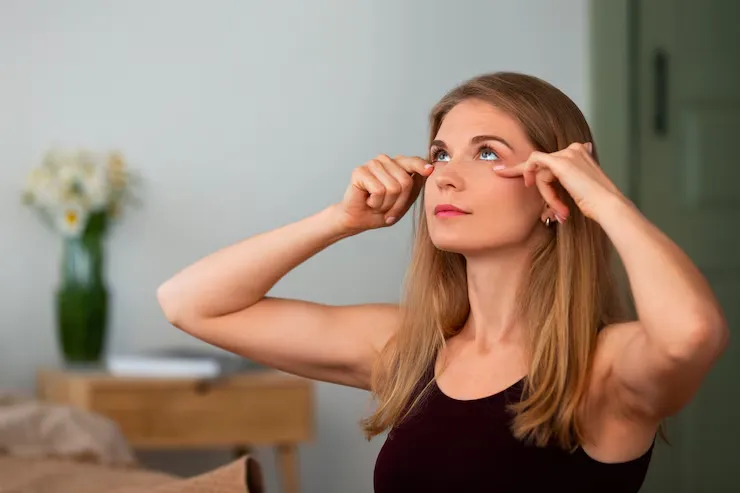Workplace Eye Health
Benefits of Blue Light Filtering Lenses
FSDAVCFEBFEVSDDVFSD
FSDAVCFEBFEVSDDVFSD
FSDAVCFEBFEVSDDVFSD
Understanding Blue Light Exposure
Blue light, a high-energy visible light from digital screens, LED lighting, and the sun, plays a dual role in our lives. While natural exposure helps regulate circadian rhythms, excessive artificial blue light from prolonged screen time can cause digital eye strain. Symptoms like dry eyes, blurred vision, and headaches are common among office workers due to continuous exposure.
Studies highlight that blue light can disrupt sleep patterns and contribute to eye discomfort, reducing overall productivity. To counter these effects, implementing protective measures such as blue light filtering lenses is essential. These proactive steps help alleviate eye strain, ensuring better eye health and improved workplace performance.
Blue light, a high-energy visible light from digital screens, LED lighting, and the sun, plays a dual role in our lives. While natural exposure helps regulate circadian rhythms, excessive
artificial blue light from prolonged screen time can cause digital eye strain. Symptoms like dry eyes, blurred vision, and headaches are common among office workers due to continuous exposure.

Studies highlight that blue light can disrupt sleep patterns and contribute to eye discomfort, reducing overall productivity. To counter these effects, implementing protective measures such as blue light filtering lenses is essential. These proactive steps help alleviate eye strain, ensuring better eye health and improved workplace performance.

Alleviating Digital Eye Strain
Digital eye strain, also known as computer vision syndrome, refers to a collection of eye and vision-related issues caused by prolonged screen use. Common symptoms include eye fatigue, dryness, blurred vision, and headaches. As more individuals spend extended hours in front of digital devices, these symptoms have become increasingly prevalent, particularly among office workers. The constant focus on screens can overwork the eyes, leading to discomfort and reduced productivity.
Blue light filtering lenses have been specifically designed to address this issue by reducing the amount of blue light that reaches the eyes. Blue light, emitted by screens and artificial lighting, is a significant contributor to digital eye strain. By incorporating these lenses into daily use, individuals can significantly minimize eye strain and experience greater visual comfort. These lenses work by blocking or filtering blue light, which helps reduce fatigue, dryness, and other discomforts associated with prolonged screen time.
In addition to using blue light filtering lenses, adopting simple practices like the 20-20-20 rule can provide further relief. This rule encourages individuals to take a 20-second break every 20 minutes by looking at something 20 feet away. Regular eye exams are also essential for maintaining optimal eye health and updating prescriptions as needed. These proactive steps help manage digital eye strain and protect long-term vision.
Enhancing Workplace Productivity

Eye discomfort, particularly from digital eye strain, can greatly affect an employee's ability to focus and perform tasks efficiently. Symptoms like headaches, dry eyes, and blurred vision can lead to frequent distractions and decreased productivity. By incorporating blue light filtering lenses, which reduce the amount of blue light reaching the eyes, employees can experience relief from these symptoms. This, in turn, helps them maintain focus and work for longer periods without discomfort.
Including blue light filtering lenses in workplace wellness programs is a proactive approach to promoting employee health and efficiency.

Employees who use these lenses report fewer headaches and reduced visual fatigue, leading to more sustained work periods and improved overall performance. Prioritizing eye health in the workplace not only supports well-being but also boosts productivity, making it a valuable investment for both employers and employees.
Prioritizing eye health in the workplace is essential for supporting employee well-being. With the increasing reliance on digital devices, many employees experience digital eye strain, leading to discomfort such as headaches, dry eyes, and blurred vision. These issues can negatively impact an employee’s mood, focus, and overall health. By addressing eye health proactively, employers show a commitment to creating a supportive work environment that values employees' physical well-being.
One effective way to reduce digital eye strain is by incorporating blue light filtering lenses into workplace wellness programs. These lenses can significantly reduce exposure to blue light, which is a primary cause of eye fatigue from prolonged screen use. Employees who use blue light filtering lenses often report fewer headaches and less eye discomfort, leading to better focus and productivity. When employees feel physically supported and less distracted by eye discomfort, they are more likely to perform at their best, contributing to enhanced overall performance. Investing in eye health initiatives not only improves the well-being of employees but also benefits employers by boosting efficiency and job satisfaction.
Benefits for Office Workers
Wearing blue light filtering lenses provides significant benefits for individuals who spend long hours in front of screens. These lenses help reduce the discomfort caused by glare and excessive screen brightness, improving focus and visual clarity. Office workers who use blue light filtering lenses often report feeling less fatigued at the end of the day, with fewer headaches and less eye strain. This enhanced comfort enables employees to maintain productivity without the constant distraction of eye discomfort.
In addition to relieving eye strain, blue light lenses can contribute to better sleep. By limiting exposure to disruptive blue light wavelengths, especially in the evening, these lenses help regulate the body’s circadian rhythms. This leads to improved sleep quality, which is crucial for overall wellness. With better sleep and reduced eye strain, employees experience enhanced workplace performance and overall well-being. Wearing blue light filtering lenses is a simple but effective solution for boosting both comfort and productivity in the workplace.
Improving Sleep Quality
Exposure to blue light, particularly in the evening, can disrupt the body’s natural sleep-wake cycle by suppressing melatonin production. Melatonin is a hormone that regulates sleep, and its suppression can make it difficult to fall asleep and negatively impact sleep quality. This disruption can leave individuals feeling fatigued and less focused the next day.
Wearing blue light filtering lenses during late work hours or when using screens before bedtime helps minimize this interference with melatonin production. By reducing the amount of blue light exposure, these lenses support healthier sleep patterns.
Exposure to blue light, particularly in the evening, can disrupt the body’s natural sleep-wake cycle by suppressing melatonin production. Melatonin is a hormone that regulates sleep, and its suppression can make it difficult to fall asleep and negatively impact sleep quality. This disruption can leave individuals feeling fatigued and less focused the next day.
Wearing blue light filtering lenses during late work hours or when using screens before bedtime helps minimize this interference with melatonin production. By reducing the amount of blue light exposure, these lenses support healthier sleep patterns.

Improved sleep hygiene is essential for overall health and well-being. Better sleep leads to increased alertness and enhanced performance during work hours. By incorporating blue light filtering lenses into daily routines, individuals can protect their sleep quality, improve their health, and maintain higher productivity levels.

Improved sleep hygiene is essential for overall health and well-being. Better sleep leads to increased alertness and enhanced performance during work hours. By incorporating blue light filtering lenses into daily routines, individuals can protect their sleep quality, improve their health, and maintain higher productivity levels.
Selecting the Right Lenses
When selecting blue light filtering lenses, several important factors should be considered to ensure they provide the maximum benefit. The quality of the lenses is a key consideration, as higher-quality lenses are more effective at blocking blue light and reducing eye strain. It’s essential to choose lenses that offer reliable protection without compromising visual clarity. Opting for lenses from reputable brands ensures a higher level of quality and effectiveness.
Comfort is another crucial factor when selecting blue light filtering lenses. Since many individuals wear these lenses for extended periods, especially during long work hours, comfort becomes essential. Look for lightweight and well-fitting lenses that don’t cause discomfort, pressure, or strain on the nose or ears. This can significantly improve the overall user experience and ensure that individuals are more likely to wear the lenses consistently.
In addition to basic blue light filtering, some lenses come with additional features like anti-reflective coatings. These coatings reduce glare caused by digital screens and ambient lighting, further enhancing visual comfort. Glare can contribute to eye strain, headaches, and fatigue, so selecting lenses with these additional features can provide extra protection against digital eye strain.
Consulting with an eye care professional is highly recommended when choosing the right blue light filtering lenses. They can assess your individual needs, taking into account factors like prescription strength, work environment, and screen usage habits. Regular eye exams are also important to ensure that the lenses continue to meet your visual requirements and provide optimal protection against blue light exposure. By making informed choices and seeking professional guidance, you can ensure that your lenses offer both comfort and protection.
Integrating Eye Care into Daily Routine
In addition to wearing blue light filtering lenses, implementing comprehensive eye care practices can significantly enhance visual comfort. Ensuring proper lighting in workspaces helps reduce glare, which can contribute to eye strain. Using diffused, natural light or adjustable desk lamps can create an optimal working environment for your eyes.

In addition to wearing blue light filtering lenses, implementing comprehensive eye care practices can significantly enhance visual comfort. Ensuring proper lighting in workspaces helps reduce glare, which can contribute to eye strain. Using diffused, natural light or adjustable desk lamps can create an optimal working environment for your eyes.
Maintaining an appropriate distance from screens and adjusting screen brightness to comfortable levels are also important steps in reducing eye strain. Keeping the screen about an arm's length away and adjusting the brightness to match ambient lighting can prevent unnecessary strain on the eyes.
Maintaining an appropriate distance from screens and adjusting screen brightness to comfortable levels are also important steps in reducing eye strain. Keeping the screen about an arm's length away and adjusting the brightness to match ambient lighting can prevent unnecessary strain on the eyes.
Incorporating regular breaks and eye exercises is essential for relieving strain. Following the 20-20-20 rule, where you look at something 20 feet away for 20 seconds every 20 minutes, can give your eyes a rest. Finally, scheduling routine eye exams ensures that any potential issues are detected early, allowing for timely updates to prescriptions and supporting long-term eye health.
Conclusion
Blue light filtering lenses are a valuable tool for office workers looking to combat digital eye strain. Prolonged screen time often leads to discomfort, including headaches, dry eyes, and blurred vision. By wearing blue light filtering lenses, individuals can reduce these symptoms, enhancing their focus and productivity throughout the workday. These lenses block harmful blue light emitted by digital devices, providing much-needed protection for the eyes.
In addition to reducing eye strain, blue light filtering lenses can improve sleep quality. Excessive exposure to blue light, especially in the evening, can interfere with the body’s natural sleep-wake cycle, leading to difficulty falling asleep. By incorporating these lenses into daily routines, office workers can mitigate sleep disruptions and promote better overall well-being. Combined with regular eye care practices, such as maintaining proper lighting and taking breaks, blue light filtering lenses support long-term eye health in today’s digital-centric work environments.

Contact Info
Hours of Operation
Mon - Fri | 9:00 AM - 5:00 PM
Sat - Sun | Closed
Holiday Hours: We are closed for the following holidays: New Years Day, Memorial Day, Independence Day, Labor Day, Thanksgiving Day, Christmas Day
© 2025 Kleinwood Vision. All rights Reserved.


